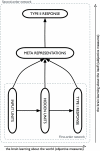The Radical Plasticity Thesis: How the Brain Learns to be Conscious
- PMID: 21687455
- PMCID: PMC3110382
- DOI: 10.3389/fpsyg.2011.00086
The Radical Plasticity Thesis: How the Brain Learns to be Conscious
Abstract
In this paper, I explore the idea that consciousness is something that the brain learns to do rather than an intrinsic property of certain neural states and not others. Starting from the idea that neural activity is inherently unconscious, the question thus becomes: How does the brain learn to be conscious? I suggest that consciousness arises as a result of the brain's continuous attempts at predicting not only the consequences of its actions on the world and on other agents, but also the consequences of activity in one cerebral region on activity in other regions. By this account, the brain continuously and unconsciously learns to redescribe its own activity to itself, so developing systems of meta-representations that characterize and qualify the target first-order representations. Such learned redescriptions, enriched by the emotional value associated with them, form the basis of conscious experience. Learning and plasticity are thus central to consciousness, to the extent that experiences only occur in experiencers that have learned to know they possess certain first-order states and that have learned to care more about certain states than about others. This is what I call the "Radical Plasticity Thesis." In a sense thus, this is the enactive perspective, but turned both inwards and (further) outwards. Consciousness involves "signal detection on the mind"; the conscious mind is the brain's (non-conceptual, implicit) theory about itself. I illustrate these ideas through neural network models that simulate the relationships between performance and awareness in different tasks.
Keywords: consciousness; emotion; learning; neural networks; subjective experience.
Figures



References
-
- Baars B. J. (1988). A Cognitive Theory of Consciousness. Cambridge: Cambridge University Press
-
- Brunel L., Oker A., Riou B., Versace R. (2010). Memory and consciousness: trace distinctiveness in memory retrievals. Conscious. Cogn. 19, 926–937 - PubMed
-
- Chalmers D. J. (1996). The Conscious Mind: In Search of a Fundamental Theory. New York, NY: Oxford University Press
-
- Chalmers D. J. (2007a). “The hard problem of consciousness,” in The Blackwell Companion to Consciousness, eds Velmans M., Schneider S. (Oxford: Blackwell Publishing; ), 225–235
LinkOut - more resources
Full Text Sources
Miscellaneous

